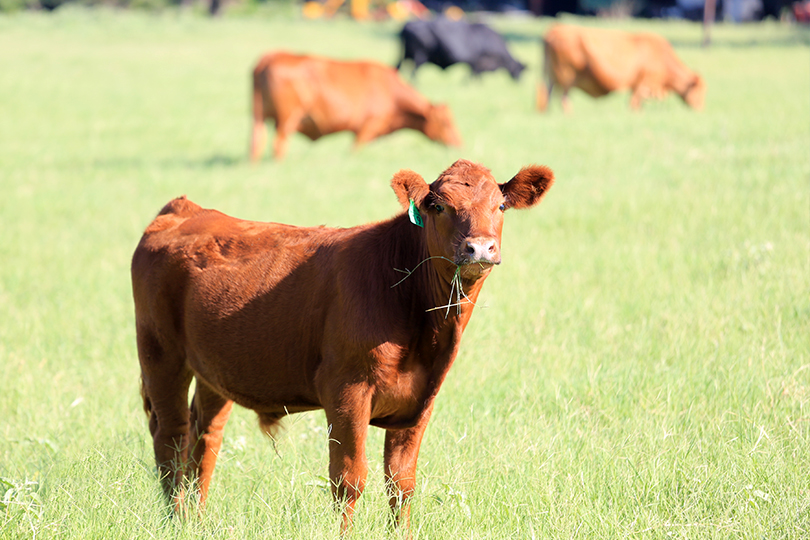By Jennifer Whitlock
Field Editor
The U.S. beef sector has long implemented sustainably practices to get beef from gate to plate, Elanco Animal Health Chief Sustainability Officer Dr. Sara Place said.
Many media reports, however, portray cattle flatulence as a source of major methane emissions contributing to climate change and global warming. But Place said while cattle do contribute to greenhouse gas emissions in the U.S., they are nowhere near the main source.
Agriculture accounts for just 10 percent of greenhouse gas emissions by economic sector. Transportation and electricity are the leading causes of greenhouse gas emissions at 29 percent and 25 percent, respectively.
And while ‘farting cows are destroying the environment’ makes for an attention-grabbing headline, Place said that’s not exactly the entire story, either.
Cattle do release methane, but mostly through eructation, or burping.
Place said it’s a natural process when the cow’s stomachs break down food.
“Cattle are basically big fermentation vats. They put grass and other foodstuffs in there, fermentation takes place and a subset of microbes in the cow’s gut make methane gas as they break down the food. And about once a minute, the animal removes methane and carbon dioxide, mainly through belching. If they didn’t, they would get bloat. So, it’s a natural part of the process.”
Climatologists worry about methane because it is more efficient at trapping radiation than carbon dioxide, but Place said the gas is fairly short-lived.
“Methane is a potent greenhouse gas, about 28 times more potent than carbon dioxide on a 100-year timeframe. But methane is continuously being broken down in the atmosphere to carbon dioxide,” she said. “From a practical perspective, holding cattle industry methane emissions constant or even slightly declining those emissions means the industry itself is not going to contribute to further additional warming.”
In fact, total greenhouse gas emissions from the beef cattle industry have remained stable over the past decade.
Place noted U.S. Department of Agriculture (USDA) cattle inventory reports show roughly the same number of cattle in 1990 as this year, but beef production has increased 18 percent over that same time period.
Essentially, cattle ranchers are creating more beef with fewer emissions.
“The cattle themselves are slightly larger, so they emit a little bit more gas. Bigger animals eat more and that means more fermentation and more gas per animal,” she said. “But the amounts that beef production has grown is greater than that. So, there’s a positive story there of essentially decoupling production of beef from emissions, which is really, really important in this whole conversation.”
Ranchers have made those changes not only because they do care about the environment, but because they practice good business sense, she said. The cattle production sector has made great strides in reproductive efficiency, genetic selection and proper nutrition, which Place said all contribute to lessening greenhouse gas emissions.
A recent study showed eliminating not just beef cattle, but all livestock and poultry raised in the U.S., would only reduce greenhouse gas emissions by 2.6 percentage points. The percentage is important to note, Place said, because according to EPA, animal agriculture is responsible for about 4 percent of emissions.
“So, when you get rid of all animals, you don’t actually reduce emissions by 4 percent. That’s because there are consequences to that decision,” she said in an interview with the Texas Farm Bureau Radio Network. “Think about it from a nutrient cycling standpoint. Crops are grown and the parts we can’t eat, byproducts, get fed to animals. Then, we recycle those nutrients back to crops in the form of manure. But when we get rid of the animal in the equation, we have to use more synthetic fertilizer.”
And synthetic fertilizer production creates greenhouse gas emissions, negating any possible positive effect from stopping animal agricultural production.
Furthermore, the same study showed nutritional consequences to Americans if animal protein were taken out of the equation. Without animal foods, dietary sources of essential micronutrients and vitamins, particularly vitamin B12, would be severely lacking.
“In that scenario, the food supply would be nutritionally inadequate. We wouldn’t be able to supply enough micronutrients to all 330 million Americans in this country. That’s not a good trade-off,” Place said.
But all this evidence doesn’t mean the U.S. beef cattle industry isn’t interested in reducing methane emissions, however.
Ranchers truly care about the environment, and they care about sustainability, Place said. Because a beef industry that’s not sustainable is ultimately not viable. And like any other industry, the beef supply chain must stay profitable to stay in business.
Agricultural researchers across the country are studying innovative ways to further minimize methane emissions in beef cattle, including adding seaweed to cattle diets.
Place said sustainability will remain a large piece of the profitability puzzle as U.S. beef cattle production continues to evolve.
“The beef cattle industry has been around for quite some time. We know ruminant animals are very sustainable from a standpoint of upcycling inedible plants for humans into higher quality products. The basics of the industry are quite sound, it’s more about us just continuously improving over time,” she said. “The key criterion for business owners is that a change must be economically viable, even as market conditions change. That’s always going to be a bit of a moving target. So, sustainability is always that goalpost on the horizon that keeps moving every time we reach it.”


Excellent explanation of the science behind sustainability.